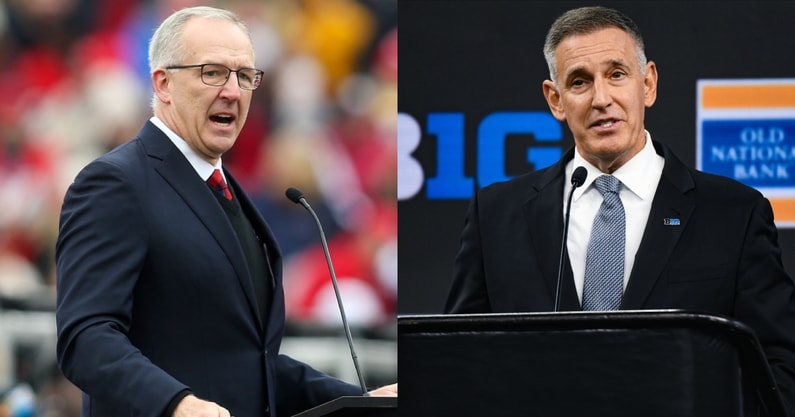Discussing the economic factors, confusion in college programs potentially joining a super league

The latest round of nationwide conference realignment will fully come to fruition later this year, as every single Power Five conference will look different starting this upcoming football season. But despite not a single game being played yet under these new circumstances, some have already starting looking ahead to the next round of realignment.
Many forecast one super league or two super conferences forming in the future that will consist only of college sports’ top football programs. Which college football analyst Cole Cubelic recently discussed on Andy Staples On3.
The first order of business would be joining the super league, with Cubelic referencing SMU‘s recent willingness to join the ACC without taking any money from the league’s television deal for up to nine years. Forecasting a similar scenario of teams trying to join a potential super conference.
“I don’t think that stuff’s gonna matter, I really don’t,” Cubelic said. “Because I think there’s gonna be so much money thrown at this and they know that there’s gonna be so much money that could potentially be made … I think it’s kind of that situation where all these teams are probably gonna try to cut these deals to get in. I’m not sure that’s gonna matter at all.”
Programs would be lined up out of the door to join a potential super league in the future, granted the opportunity to capitalize on a momentous money-making opportunity in a sport that’s rapidly growing in generating revenue. But the push towards a super conference would be pushing towards a more professional sports model compared to traditional college athletics model, which presents several questions.
“I think the most interesting part is if we’re talking about expanding or we’re talking about this private equity portion of this, and I had two really long conversations with people that are very familiar with things like this that know this,” Cubelic said. “How do you place a value on a college football program?”
“How do you create a valuation for Alabama football? Or Texas football? Or Clemson football?” Cubelic asked. “And the main reason I think it’s confusing is because a very large portion of what is equitable with them has been essentially given to them.”
Top 10
- 1New
CFP Top 25 predictions
Projecting first rankings
- 2Hot
BCS Formula
Predicts first CFP Top 25
- 3
Heisman Trophy Poll
Top 10 rankings after Week 10
- 4Trending
Auburn Hot Board
Top candidates to replace Freeze
- 5
Bowl Projections
Full list of postseason matchups
Get the Daily On3 Newsletter in your inbox every morning
By clicking "Subscribe to Newsletter", I agree to On3's Privacy Notice, Terms, and use of my personal information described therein.
The infrastructure of college athletic programs is largely predicated on alumni donations contributing to the cause. Something that is not seen with professional franchises like the Dallas Cowboys or Golden State Warriors that eclipsed valuations over $7 billion entering 2024.
“Or let’s go a step further than that, let’s go to Auburn’s new facility they have or Clemson has a putting green and a slide. Well people gave you money for that, not because you were worth a lot, not because they wanted to adjust your worth or value. They just like you so they gave you that money,” Cubelic explained. “Does that equate to part of what you’re worth? What people have or will continue to give you? Like I literally have no idea how that portion of it would work.”
Cubelic forecasts that some of these land grant institution schools would begin to capitalize on stadiums and arenas in this scenario, potentially hosting concerts and other outside sporting events to generate revenue. Also predicting that a super league would have a positive impact on name, image, and likeness for student-athletes.
“There’s not a lot cool about this if it does happen in my opinion, but one thing that could be cool that happens is NIL or what we deem it,” Cubelic said. “I actually think you would start seeing that become very real … And it’s not gonna be over-inflated numbers, it’s not gonna be enticement. It’s going to be hey, we can put you in a uniform in this commercial because this guy own that company that technically owns three quarters of our football program.”
More structure and organization surrounding NIL is needed in today’s college sports landscape, particularly regarding its relation to recruitment. And while the structure of a super conference may aid in that, it feels like overall college football is far from ready to pursue a super league given the various short-term and long-term questions presented in today’s current landscape.